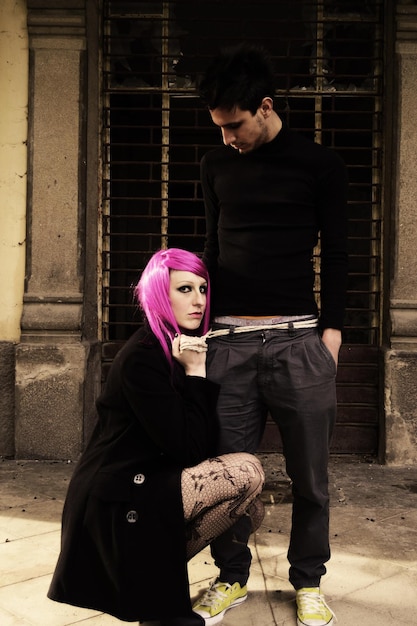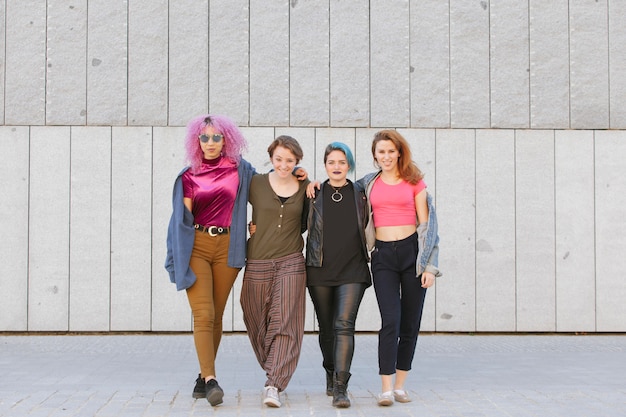The Evolution of Emo Style: From 2000s to Today’s TikTok Trends

The Evolution of Emo Style: From 2000s to Today’s TikTok Trends showcases a transformation from raw emotional expression through music and fashion in the early 2000s to its modern adaptation on TikTok, influenced by new aesthetics and a broader audience.
The Evolution of Emo Style: From 2000s to Today’s TikTok Trends reveals how a subculture rooted in emotional expression has morphed into a contemporary aesthetic embraced by a new generation. From its origins in music and fashion to its current manifestations on social media, emo has undergone a significant transformation.
The Origins of Emo: Music and Fashion
Emo began as a subgenre of hardcore punk, emerging in the 1980s. However, it was in the early 2000s that emo truly captured mainstream attention. Key to understanding its evolution is recognizing its inextricable link to both music and fashion.
The Musical Roots of Emo
Emo music, characterized by its confessional lyrics and emotional delivery, provided the soundtrack for the burgeoning subculture. Bands like My Chemical Romance, Fall Out Boy, and Paramore became anthems for a generation.
Fashion as a Form of Expression
The fashion was more than just clothing; it was a visual representation of the emotional depth found in the music. The style allowed fans to express themselves through clothing. It was accessible and DIY in many ways.

Here are some key elements that defined the early 2000s emo fashion scene:
- Black Skinny Jeans: A staple in every emo kid’s wardrobe, often paired with band t-shirts.
- Band T-shirts: Displaying allegiance to favorite emo and rock bands.
- Side-Swept Bangs: Heavily styled and often covering part of the face, symbolizing introspection.
- Studded Belts: Accessorizing with studded belts emphasized the raw style.
The origins of Emo are essential in understanding the current trends and how different generations have contributed to the evolution. From music to fashion, the message was clear and allowed many to connect in different ways.
The Mid-2000s Emo Boom: Mainstream Acceptance and Evolution
As the mid-2000s approached, emo became a cultural phenomenon. The music gained even greater mainstream acceptance, appearing on MTV and receiving significant radio airplay. The fashion, embraced even outside the music scene, began to subtly evolve.
The Rise of Scene Influence
The “scene” aesthetic, characterized by brighter colors, bolder hairstyles, and a generally more flamboyant look, started to seep into emo fashion. This marked a shift from the darker and more introspective style of early emo.
Hybrid Styles and Experimentation
During this period, hybrid styles emerged, blending emo with elements of punk, goth, and even pop. Individuals began experimenting with different looks, finding ways to express their unique identities within the broader emo framework.

The following attributes contributed significantly to the evolution during the mid-2000s:
- Brighter Colors: The use of neon colors, particularly in hair streaks and accessories.
- Teased Hair: More volume and elaborate styling became popular, moving away from the more straightforward side-swept bangs.
- Accessories: Colorful bracelets, necklaces, and other accessories added a playful touch to the darker emo base.
Ultimately, the mid-2000s represented a period of greater creativity and self-expression within the emo subculture. The willingness to experiment and blend styles led to diverse looks, pushing its boundaries of definition.
The Late 2000s Decline and Shift in Focus
As the late 2000s approached, the peak popularity of emo began to decline. Shifts in mainstream music tastes and cultural trends led to a gradual decrease in emo’s visibility. However, this didn’t mean the end; rather, it signified a shift in focus.
The Indie and Alternative Influence
With emo losing some of its mainstream appeal, many within the subculture began to explore indie and alternative music. This influenced a shift towards simpler, more understated fashion choices.
Emphasis on Individuality
The late 2000s saw an increasing emphasis on individuality. Young people who had previously identified strongly with emo started to embrace their own unique preferences, blending emo elements with other styles.
The effects of this period included:
- Understated Fashion: A move away from overly dramatic or flamboyant elements.
- Blending Styles: Incorporating elements from indie, alternative, and other subcultures.
- Personalization: Customizing clothing and accessories to reflect individual tastes.
In effect, while the late 2000s marked a decline in emo’s mainstream prevalence, it also encouraged a greater sense of individuality and personal expression within the subculture. This shift paved the way for future transformations of emo style.
The 2010s: Emo’s Underground Resurgence and Nuance
In the 2010s, emo went underground, finding new life online and in smaller communities. While it was no longer a mainstream phenomenon, emo began to evolve in more nuanced and experimental ways.
The Influence of Internet Culture
The internet played a crucial role in sustaining and transforming emo culture. Online forums, blogs, and social media platforms allowed fans to connect, share ideas, and cultivate new styles.
The Rise of “Sadboi” Aesthetics
The term “sadboi” emerged as a distinct aesthetic, characterized by a melancholic and introspective vibe. This involved fashion themes and music selection.
Key developments during this period included:
- Online Communities: Flourishing online spaces dedicated to emo music, fashion, and culture.
- DIY Fashion: A renewed emphasis on creating unique, handmade clothing and accessories.
- Emotional Vulnerability: Openly expressing emotions and embracing vulnerability became increasingly important.
The 2010s saw emo culture embrace introspection and honesty. The internet played a pivotal role in allowing individuals within the emo community to share ideas, form personal connections, and express themselves.
Emo on TikTok: A New Generation’s Interpretation
TikTok has introduced emo to a new generation. Today’s emo style on TikTok blends elements of the classic 2000s look with current fashion trends, creating something entirely new.
Adapting Trends for a Digital Age
TikTok users incorporate vintage emo elements with current trends like oversized clothing, platform shoes, and graphic eyeliner. This creates a unique and personalized styles.
The Role of Influencers
TikTok influencers play a significant role in shaping and promoting emo trends. Their creative content inspires others to experiment with their looks and express themselves authentically.
TikTok’s influence reflects:
- Creative Expression: Encouraging users to create their own distinctive styles.
- Community Building: Connecting like-minded individuals through shared interests in emo culture.
- Promoting Diversity: Showcasing different interpretations of emo style, reflecting a wide range of identities and backgrounds.
TikTok has not only revived interest in emo culture but has also transformed it. By combining nostalgic elements with contemporary trends, TikTok users have created a dynamic and evolving version of emo that resonates with a new generation.
The Enduring Legacy and Future of Emo Style
Despite its multiple transformations, emo style has left an indelible mark on fashion and culture. Its enduring legacy is characterized by emotional expression, individuality, and authenticity.
Emo’s Lasting Impact on Fashion
Emo’s influence can be seen in contemporary fashion trends, from the resurgence of skinny jeans to the popularity of band t-shirts. Many of today’s designers draw inspiration from emo’s distinctive aesthetic.
Emo as a Form of Self-Expression
Throughout its evolution, emo has served as a powerful form of self-expression. It has provided individuals with a means to communicate their emotions, connect with others, and assert their unique identities.
The future of Emo entails:
- Continued Evolution: Emo style will likely continue to evolve, adapting to current trends and influences.
- Inclusivity: Embracing diversity and representing a wide range of identities.
- Emotional Authenticity: Staying true to its roots by prioritizing emotional expression and sincerity.
Emo endures as a means for individuals to express themselves through fashion. The future holds more styles that will continue to grow with modern trends, leading to constant creativity.
| Key Aspect | Brief Description |
|---|---|
| 🎵 Music Origins | Started as a subgenre of hardcore punk in the 1980s. |
| 🖤 2000s Fashion | Defined by black skinny jeans, band tees, and side-swept bangs. |
| 📱 TikTok Trends | Blends classic emo with new trends like platform shoes and graphic eyeliner. |
| 🌐 Internet Culture | Online communities allow users to share styles while connecting with others. |
FAQ
▼
Classic emo fashion includes black skinny jeans, band t-shirts, studded belts, and side-swept bangs. These elements emphasized self-expression with a darker tone setting the tone. It also provided a unique aesthetic.
▼
Emo style on TikTok combines classic elements with current trends like oversized clothing, platform shoes, and graphic eyeliner. This has given rise to diverse interpretations, influencing users to experiment.
▼
Emo’s fall in popularity was due to shifts in mainstream music tastes and cultural trends. Many followers started to embrace individuality when customizing their style. As a result, emo’s place in pop culture shifted.
▼
The internet connected emo fans through online forums, blogs and social media sites. It became easier for fans to share ideas, form communities and evolve the style. In turn, new communities have grown online.
▼
Emo has greatly influenced today’s fashion trends as seen in the resurgence of skinny jeans and band t-shirts. Its influence is felt across today’s designers. By embracing the aesthetic, emo continues to be innovative.
Conclusion
From its roots in music and fashion to its modern interpretation on TikTok, the evolution of emo style reflects a continuous journey of self-expression and reinvention. Through these styles the culture has lived on through multiple generations who have had the chance to create their own identity and unique perspectives.
